Chase Down Roofing Leads? Or Draw Them to You?
Table of Contents
- Traditional Outbound Methods to Generate Roofing Leads
- Word-of-Mouth Referrals
- Personal Selling: Door-to-Door, Cold-Calling and Trade Shows
- Direct Response and Print Advertising
- Yellow Pages
- Effective Inbound Methods to Generate Roofing Leads
- More Inbound Tactics to Generate Roofing Leads
Learn how inbound marketing is changing how you can generate roofing leads.

If you’ve been in the roofing business for any length of time, you’ve already tried various ways to generate roofing leads. You’ve likely noticed a dramatic shift in consumer behavior in recent years, thanks to social media and the internet, but perhaps you’re not sure how best to capitalize on these changes and emerging trends.
Today’s consumers are “self-directed buyers.” They have all the information at their fingertips and have done extensive research online long before they choose which product or service to buy.
They get referrals from friends and related websites, check out online reviews and usually end up selecting the company they feel they can trust the most to deliver quality, service and value.
According to Forrester Research, today’s buyers have already traversed anywhere from 66 percent to 90 percent of their journey through the buying process before they even contact you, the seller.
This shift has turned lead generation upside down. In this article, we’ll take a look at the traditional, time-tested methods of lead generation you’re probably most familiar with and explore the potential power of inbound marketing to help you generate roofing leads for your business.
First things first, though. Generating leads is actually not that difficult. The real challenge is in generating qualified leads.
In a survey conducted by International Data Group (IDG), 61 percent of the marketing executives polled reported that generating high-quality leads was a challenge for their organization.
Ask yourself these three questions:
- Are you showing up where potential customers are most likely to look for you?
- Do you clearly communicate the reasons why your company is a better choice than your competitors?
- Do you even know what those reasons are yourself? It’s amazing how many business owners have not determined their own unique selling proposition (USP).
The answers to the above three questions will apply whether you use traditional methods of lead generation (mostly outbound) or more current, digital methods (mostly inbound).

Inbound? Outbound? Where should you put your time, attention and resources to serve your audience and your business best?
Ideally, your marketing strategy should include a mix of inbound and outbound tactics. According to Marketo, combining the two can multiply the number of views you generate, dramatically increase sharing and ultimately increase the number of potential customers who see your content.
Let’s take a look at various methods of traditional and digital lead generation. We hope you’ll find some actionable, affordable ideas that you can implement right away to enhance your current efforts and deliver measurable, bottom-line results.
Traditional Outbound Methods to Generate Roofing Leads
Here’s a list of the most commonly used traditional or “outbound” methods that contractors and business owners use to obtain roofing leads. Chances are, you’ve already tried a few of them with varying degrees of success.
If you didn’t achieve the desired results, don’t make the mistake of thinking the tactic doesn’t work. Rethink what you did, learn from any mistakes and try these methods again:
- Word-of-mouth referrals.
- Personal selling: door-to-door, cold-calling and trade shows.
- Outdoor advertising.
- Direct response and print advertising.
- Yellow Pages.
Word-of-Mouth Referrals
It has long been said that word of mouth is the best possible form of advertising. In the online world, that can mean social proof in the form of testimonials, reviews and referrals from other sites. In the traditional sense, it means that your satisfied customers are recommending you to their friends, relatives and other acquaintances with great confidence in your products and services.
According to John Jantsch, small business marketing consultant and author of the bestselling books Duct Tape Marketing and The Referral Engine, most business owners recognize the value of referral marketing but few have systems in place to make it a regular part of their marketing and lead generation strategy.
He suggests three simple, low-cost ways of doing just that. First of all, ASK! Train your staff to ask customers for referrals during the sales cycle and when following up post-project. Print something on your invoices such as, “If you love what we did for you, we’d really appreciate having you send us a referral.” Send a personalized thank-you note for their business and, again, ask for their referrals.
Jantsch stresses that, no matter how you decide to ask for referrals, it’s critical that you make it easy for people to do. He asserts that we human beings are hardwired to help each other. In his book, Influence: The Psychology of Persuasion, behavioral psychologist, Dr. Robert Cialdini, concurs that reciprocity, the idea of returning a favor when one is received, is a foundational component of influence.
Personal Selling: Door-to-Door, Cold-Calling and Trade Shows
Have you noticed that, these days, we’re all connected yet very few people know how to communicate? Face-to-face communication is so rare in our digital world that it can really help you stand out, make a lasting good impression and start a sales conversation, provided you do it well.

These prohibitions, and the online equivalent of anti-spam rules, make personal selling a challenge.
Door-to-door sales calls are generally not appreciated by homeowners. They’re also time and labor-intensive for you, as the marketer. However, they can be well worth your effort if the prospect is definitely qualified (for example, there’s visible roof damage after a storm).
You can also take a less direct approach by simply leaving a dangler with your contact information on the doors of homes in a neighborhood where you’ve started or recently completed a roofing job.
Controversy rages over cold-calling. While some would have you believe it’s dead, MarketingSherpa stated in a business technology marketing presentation that “cold-calling is second only to referrals as the number one lead generation tactic.”
Here are the three “Cold-Calling Rules for the 21st Century,” according to Stefan Tornquist:
- Have a Targeted List.
Before you start a cold-calling campaign, you need to understand the people you’re trying to reach. Create an ideal customer profile (often called a “persona” in order to establish your qualifying criteria). Don’t waste your time trying to sell something that the person you call doesn’t want, will never need or can’t afford. Where do your prospects live? Do they have a family? Are they young professionals or retirees? Do they subscribe to home décor, landscaping or similar sites and publications? What home problems keep them up at night? - Answer Your Prospect’s Question: What’s In It for Me?
This requires a fair bit of research on your part to discover what solutions you can offer that are relevant to your prospects’ needs or desires. Are they concerned with energy efficiency and environmental issues? Have they had a bad experience with contractors in the past? What problems are they currently facing and how can you help solve them? What do you do differently from your competition that helps your customers? (This is why it’s so important to know what your USP is). - Understand the Goal of Your Call.
Too often, marketers think that the purpose of a cold call is to make a sale. This mindset creates pressure for both the caller and the prospect, which can create negative feelings and usually results in no sale. A cold call is merely an introduction to you and your company. It’s a reciprocal learning process and you, as the caller, should always listen more than you talk. Ask open-ended questions to zero in on the prospect’s needs and strive to become a friendly advisor who seeks to help rather than sell. The time to sell comes much later in the cycle, after you’ve established a relationship and nurtured trust. An open-ended question is one that prompts your prospect to reply with more than a yes or no answer. You might ask him or her to tell you what’s most appealing about a neighbor’s new roof, for example.

Trade Shows
While trade shows are most often associated with business-to-business selling, most communities have annual or semiannual home shows that are well-attended by consumers seeking very specific products and services related to home construction, renovation and repair. Like yours!
These events offer you a great opportunity to meet and begin a relationship with potential customers, ethically collect email addresses, pass out company literature and position yourself as a go-to expert, especially if you’re able to conduct how-to seminars or deliver valuable educational content.
Outdoor Advertising.
You don’t have to spend big money on giant billboards to keep your name in front of potential leads. Vehicle graphics and yard signs that are clean, professional-looking, well-maintained and properly, consistently branded with your company name and colors will help people remember and think of you first when they need your services.
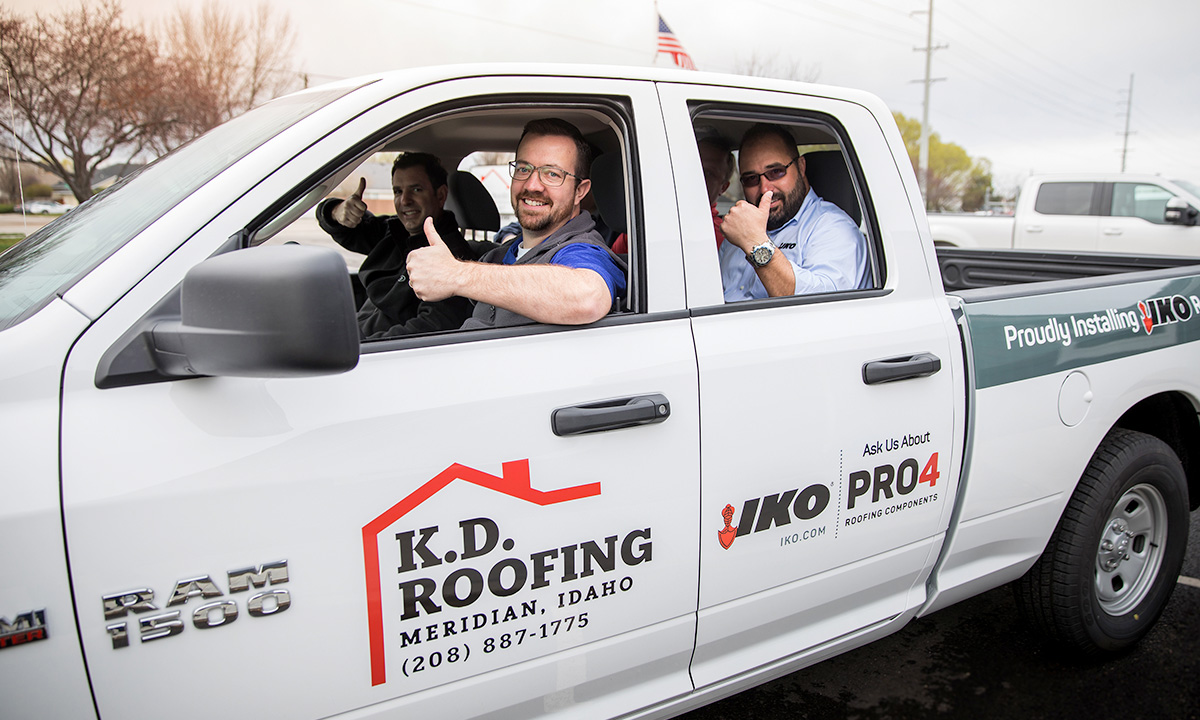
If your roofing company does have the means to invest in billboard advertising, be sure to keep the message simple, the text large with consistent fonts and sizes and the artwork uncluttered.
Motorists passing by do not have time to read your company’s history and accreditations, and they will not squint to see fine print. Make the message about understanding and solving your prospect’s problem; don’t make it all about you. When it comes to outdoor billboards, less is always more.
Direct Response and Print Advertising
Albert Lasker was a pioneering ad executive who once defined advertising to President Kennedy as “salesmanship in print.” Before the advent of electronic media (radio and television) and digital/social media, direct mail was the most measurable, results-oriented type of advertising.
Advertisers bought lists of names that fit the demographics for their products and mailed physical letters (the longer the copy, the better the response) and included a very specific call to action. The pieces relied on scarcity, discounts and/or limited-time offers and always included a response mechanism.
The recipient had to clip out a coupon, fill in a form, phone a 1-800 number, return a postage-paid business response card (BRC), provide contact information in the enclosed self-addressed stamped envelope or respond in some other way that the advertiser could easily track and measure.
Direct mail still exists today but it’s now under the umbrella of “direct response” in order to include vehicles other than traditional or “snail” mail. However, since regular mail has largely been supplanted by digital, online advertising, it can be extremely effective, especially in local markets. Like personal selling, letters in the mailbox have become so rare, they really stand out from the crowd.
Long-form, copy-heavy direct mail letters may not work as well as they once did because of people’s shortened attention spans and information overload. But postcards and similar, simpler pieces can keep your roofing company’s name in front of prospects and you can tailor your pieces to include a specific offer or call to action that allows you to measure response and effectiveness.
To get the most value out of your advertising spend, be sure that flyers or print ads in your local newspaper or in magazines follow the principles of direct response in that you include a specific call to action that allows you to quantify and measure the results.

Electronic media were once the domain of image or institutional advertising for large companies with very deep pockets and national reach, such as Coca-Cola and General Mills to create brand awareness. Although radio and TV ads could be somewhat targeted based on the audiences for those channels’ programming, they were really a shotgun approach of marketing to the masses that could not be quantified to determine their effectiveness.
Media fragmentation is both a blessing and a curse for advertisers today. On the one hand, only the large conglomerates like those above can afford to advertise on enough channels to reach a mass market.
On the other hand, there’s a channel, vehicle, print or online publication to serve every imaginable interest group so finding the right medium to target and reach your best prospects and generate roofing leads can be easier than ever.
Yellow Pages
Whether you advertise in the traditional, physical version of this familiar vehicle or its digital, online counterpart, the Yellow Pages are a form of outbound advertising that allows you to place display ads. There are many online directories where you can, and should, list your roofing company for free. Here’s a list of more than 20 of them. Most have upgrade options for a minimal monthly charge. Be sure your roofing company appears in Google’s local search directory.
Effective Inbound Methods to Generate Roofing Leads
Marketo defines inbound marketing as “the process of helping potential customers find your company – often before they are even looking to make a purchase – and then turning that early awareness into brand preference and, ultimately, into leads and revenue.”
While inbound marketing strategies may require a lot of work upfront and, ideally, regular updating for reasons we’ll discuss below, they can generate roofing leads and business 24/7 at minimal cost once they’re set up.
It’s beyond the scope of this article to discuss every possible inbound tactic but the three of most value to you, as a roofing contractor, are Search Engine Optimization (SEO), blogging and social media. All three work together, to generate leads and results that are greater than the sum of their individual parts. We’ll take a look at a few other tactics you can try, as well.
1. Website and SEO.
Having a website is an absolute must for any business and, if done correctly, it can be a lead-generating powerhouse. Too often, though, companies use this valuable online real estate to talk about themselves instead of showing visitors how they can solve their problems or educate them on different subjects.Take a good look at your website and try to see it from a prospect’s perspective. Understand that everyone who arrives at your website will be at a different stage of the buying process. Some are just looking for information. Others have been referred to you and are checking you out for fit. Still others have already done their research and are looking to purchase or at least make a sales appointment. You can learn a lot about inbound marketing for free at HubSpot the infographic below sums up the various stages of the customer’s journey through your sales funnel and beyond.
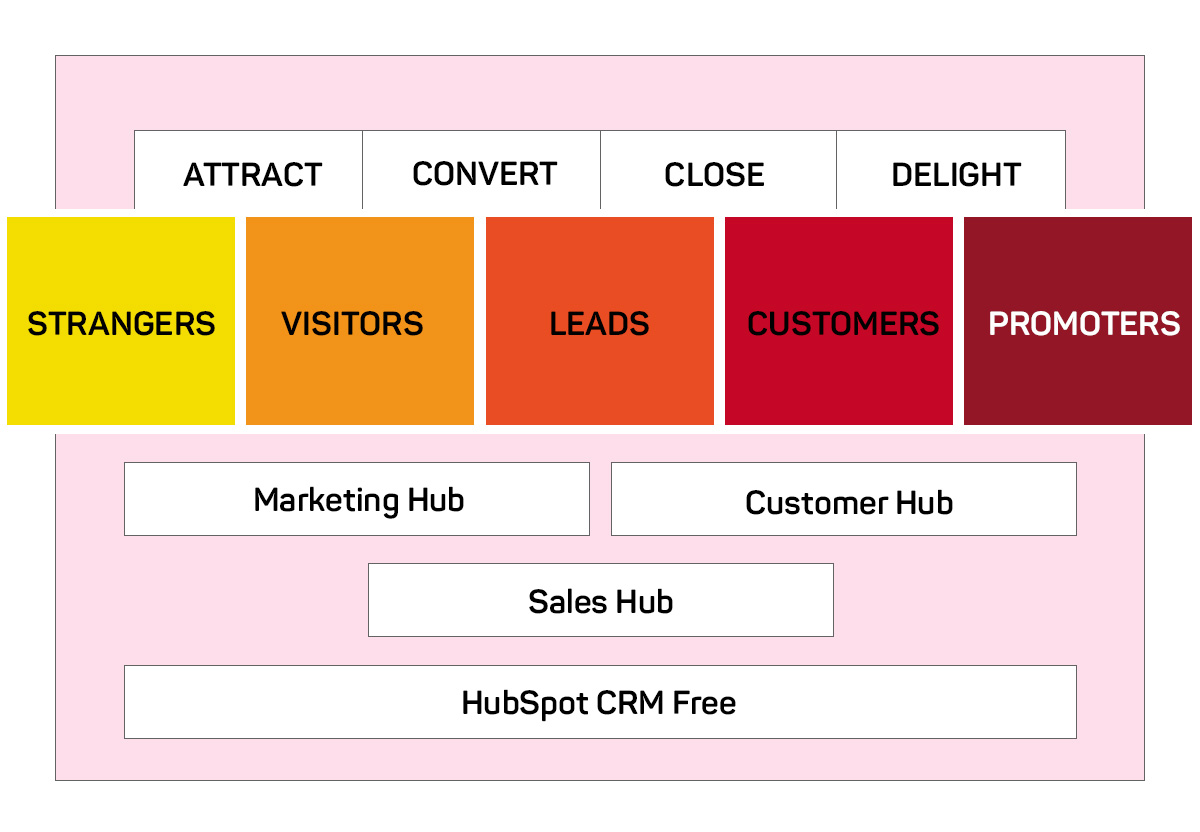
Recognizing this, you can gear your content to give each prospect exactly the help he or she is looking for no matter what stage of the process they’re at. Make it easy for them to understand your value proposition, or what makes your company different from the competition. Create an interactive experience. Allow them to download relevant, useful information such as industry reports or bulletins in exchange for their email address. It’s often said that “the money’s in the list.” Once you’ve compiled a list of qualified prospects and have their permission to email them, an autoresponder can help you nurture the leads you’ve generated. Companies like MailChimp, Constant Contact and others offer adequate basic services for free, paid upgrades based on the volume of your emailings and detailed analytics so you’ll know what’s working best. Please be sure that all your electronic communications with prospects are compliant with anti-spam legislation in your jurisdiction. For information in the US, see https://www.ftc.gov/tips-advice/business-center/guidance/can-spam-act-compliance-guide-business and for information in Canada, see https://fightspam.gc.ca/eic/site/030.nsf/eng/home.Every page or screen of your website should have a clear call to action, in order to generate roofing leads. These CTAs could be a request for more information, a button to download a lead magnet (that’s a marketing term for an irresistible free offer, such as a consultation, roof inspection, etc. in exchange for an email address), a chatbox to speak to a sales rep or any other action relevant to the content on that page. People want to know the next steps. Don’t be afraid to tell them and make it easy to do. Is your website responsive? A responsive site means that it can be easily viewed on any device (desktop, mobile or tablet). If your current site crams information full width on your desktop screen, it’s time for an overhaul.
A scrolling site works best on mobile devices, so keep your content and graphics crisp, clean and uncluttered.
Again, the most important thing you can do to generate leads is to make sure that your website has SEO. People in need of professional roofing services will start their quest by entering keywords like “roofing contractor in my area” into a search engine such as Google, Yahoo or Bing.
Google and other search engines are constantly changing their algorithms but embedding keywords into your text, adding fresh content regularly, including videos on your own website and establishing backlinks from other sites to yours will all help yours rank higher in the search results. This article from Forbes details 12 effective SEO techniques that currently work well.
If you’re not sure what keywords people will use to find your site, check out the free Google Keyword Planner tool. When you enter a search term you think people might use, you’ll get a list of other term suggestions you may not have thought of.
Keywords such as “roofing contractor” are called “short-tail” keywords and generally have a great deal of competition. By using a long-tail keyword such as “residential roofing contractors in (your city here)” you’ll have a better chance of ranking higher.
Learn more with John Jantsch’s primer on keyword research specifically for small business.
2. Blogging.
While blog posts themselves don’t generate a lot of direct leads, blogging can be one of the most effective ways to drive traffic (leads) to your website, especially if you host your blog on your own website, which is highly recommended. Because Google and other search engines seek out and reward fresh content with higher rankings, writing keyword-laden blog articles on a regular basis can attract a lot of qualified prospects to your site. Think of blogging and SEO as partners in profit!Every time you write a blog post, you can, and should, promote it on Twitter, LinkedIn and Facebook. Services like Hootsuite, Buffer and Sprout Social make it easy to co-ordinate and manage your social media platforms from a single dashboard. It’s been shown that longer blog articles work best for SEO purposes. Aim for a minimum of 1350 words per post but make the content easy for readers to absorb and relevant to your business. Break up the text with subheads; include lists, infographics, images or embedded videos; and use fonts that are pleasing to the eye. Incorporate links to areas of your own website that correspond to the article’s content. Invite visitors to comment and acknowledge them when they do.
3. Social Media.
Companies first used social media to promote their brand and generate online buzz but, increasingly, they’re using it to generate leads. By creating a presence on Twitter, LinkedIn, Facebook, Google+ and other popular platforms, you can start conversations with potential customers and meet prospects where they live online. Being active on social media allows you to engage directly with prospects and can give you a lot of valuable insights into how they talk, what their challenges are, etc. Seek out opportunities to be helpful by participating in online forums and answering questions. Once you become known as the “go-to” person of roofing, you’ll start drawing leads to your website.
More Inbound Tactics to Generate Roofing Leads
Once you know where your prospects are hanging out, create a presence on the websites they visit to generate leads and direct traffic to your own site. Here are some more bright ideas.

Referrals from online directories and websites like HomeAdvisor, Angie’s List, Yelp, HomeStars, Houzz and others through free or paid services can be well worth your investment of time or money.
Webinars are the online equivalent of seminars, like the kind you might offer at a trade or home show. Because registration is required, you can collect basic information on interested attendees.
Webinars should be free of charge and educational, never a sales pitchfest, although you may include a special discount offer on a service or a free roof inspection at the end. Always select topics that are of great interest and especially of value to your ideal target audience. Examples might be inspecting your roof for storm damage or picking the right shingle color.
Services such as GoToMeeting and FreeConferenceCall make it easy to schedule, invite attendees, moderate and even record your sessions.
Pay per click (PPC) advertising is much more cost-effective than traditional print advertising and it gets your message directly to its intended online audience. It allows you to “buy” your way onto search engine results pages for your chosen, specific and relevant keywords. You only pay when someone clicks on your ad, which they won’t do unless it’s of specific interest to them.
It’s easy to track your spend and measure your results with PPC advertising. To be most effective, your PPC ad needs to give people a reason to click and visit your website. Incentives might include a webinar, a free report, a special discount, etc. The possibilities are endless and you can try variations to test the effectiveness of each.
A search for “roofers in Des Moines” turned up four PPC ads (see below). Note the little “Ad” icon to the left of the company’s URL.
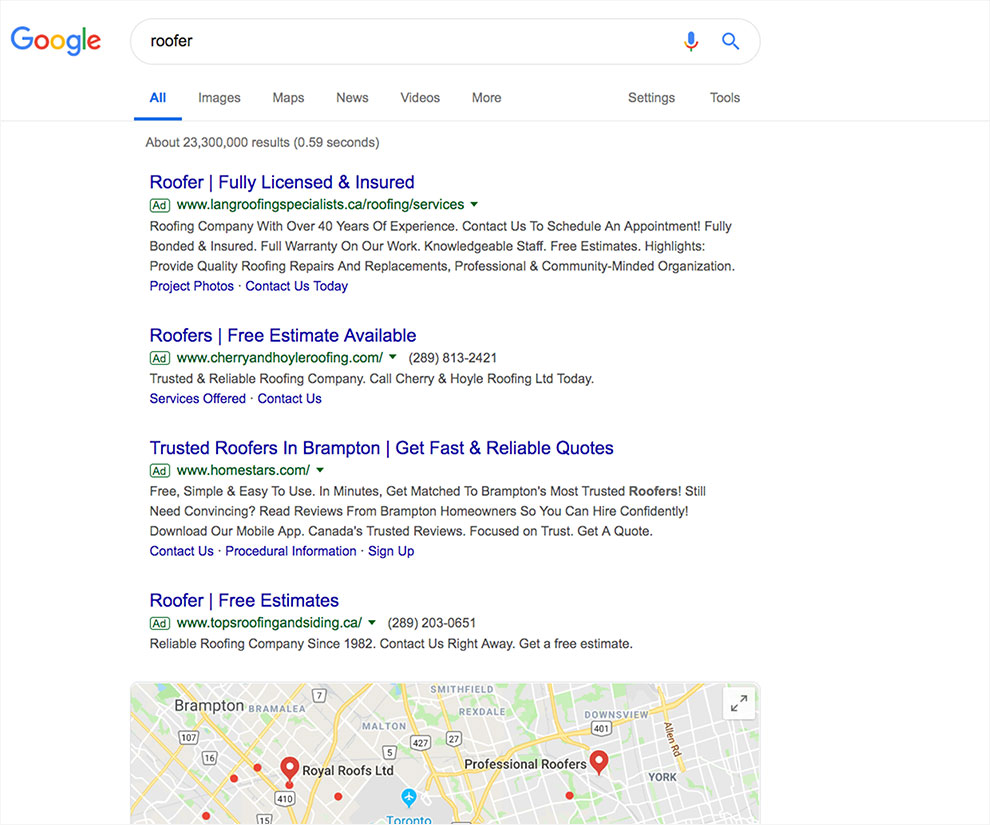
For more information, or to get started with PPC advertising, visit Google Ads.
Industry research reports, white papers and bulletins can be pieces of valuable content you can share with your email list of prospects or use as a “lead magnet”.
Content creation takes a lot of time, but content curation gives you a lot of quick wins in terms of lead generation. Industry research reports and bulletins that offer valuable insights and information to your target market can be repurposed and shared on your blog or social media networks.
White papers and their longer counterparts, e-books, make great incentives for qualified leads to click on your PPC ads. Small businesses may find them a challenge or unrealistic to create but don’t forget that you might be able to use materials someone else has created, with their permission and a credit.
You can offer them free on your website, create a special landing page for them to be downloaded in exchange for an email address or distribute them through third-party sources.
Google loves videos. In fact, the company bought YouTube in 2006 for $1.35 billion in stock. YouTube is the world’s second-largest search engine, after parent company Google.
Embedding a video onto your page might help your blog post rank higher. By optimizing a video on the YouTube platform, you can drive traffic to the video page on YouTube and you might even get it to appear on Google’s Search Engine Results Page (SERP). When sharing on social media you can include a link to your video URL on YouTube or a link to the page on your website where you’ve embedded the video.
Here’s an example of how this would look.
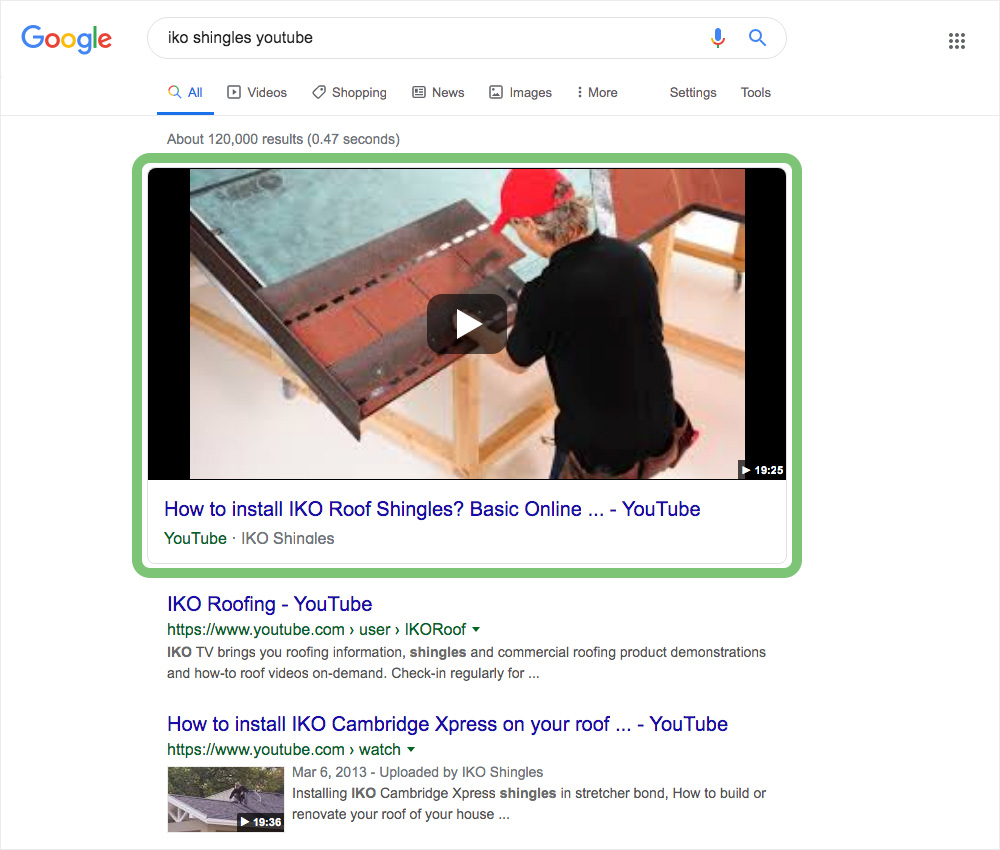
There are special social metatags you can use to optimize how the content you’re sharing on social media will be displayed in a feed such as Facebook or LinkedIn. The example below identifies important tags to consider.
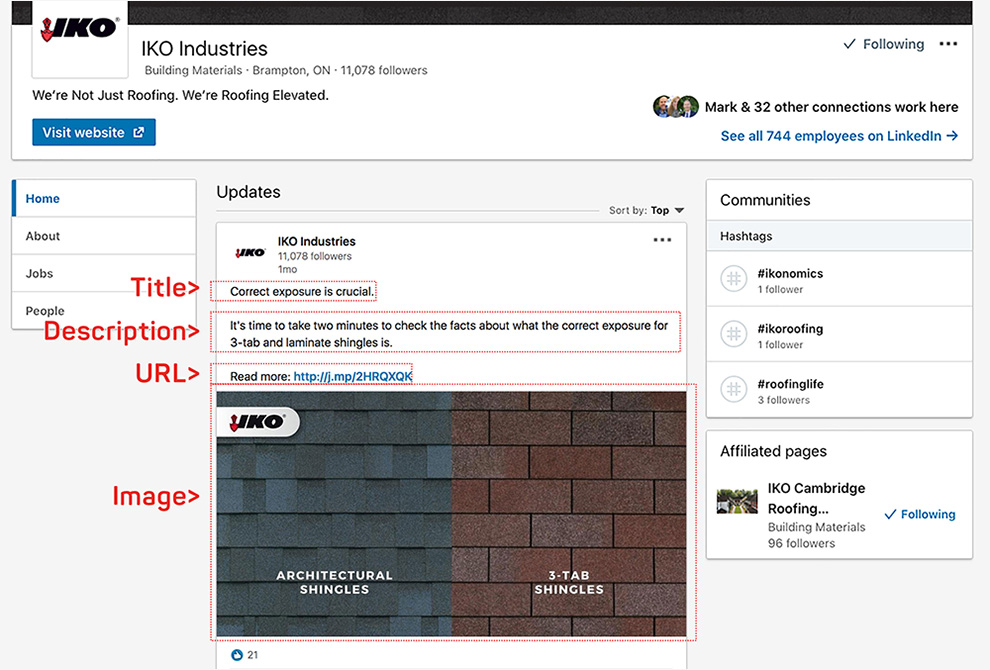
Why not create your own marketing video? Doing so helps build credibility and virtually automates the referral and lead-generating process when shared on other related websites. Video testimonials from actual customers on your own site lend social proof and are much more engaging to visitors.
Successful lead generation depends on both inbound and outbound strategies. You need to try different tactics and measure the results of each in order to determine which mix is the most effective for you.
We hope that you’ve found some of our suggestions helpful and that you’ll share your own ideas and success stories with your fellow roofing professionals.


